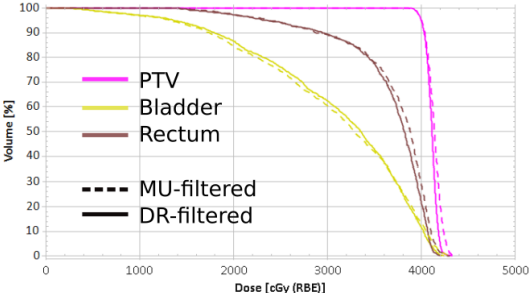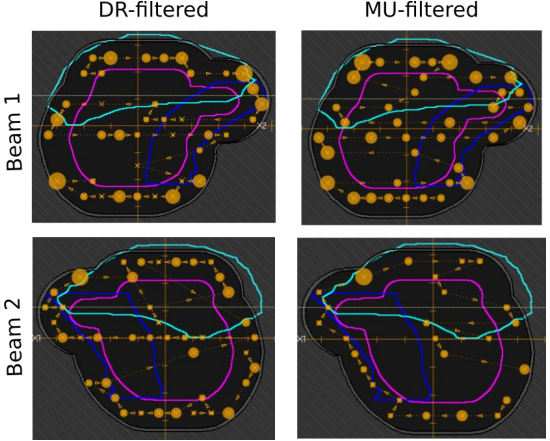The FLASH sparing effect, demonstrated in pre-clinical studies at ultra-high dose rates (UHDR), offers potential in cancer treatment. However, achieving UHDR raises plan optimization challenges, like maximizing the volume of healthy tissues receiving FLASH UHDR while optimizing the spot weights. Recent developments in conformal FLASH pencil beam scanning proton therapy have concentrated on optimizing the spot delivery pattern due to their direct impact on dose rate (DR) model. In this study the focus is shifted to spot filtering optimization, which is shown to further increase DR and potentially enhance the feasibility and effectiveness of FLASH therapy.
The algorithm uses an iterative approach to filter spots, prioritizing those whose removal maximizes the number of voxels exposed to UHDR (>40Gy/s, 5% percentile DR) rather than low-MU spots (MU-filtered), while ensuring that the resulting reconstructed dose remains closely aligned with the original dose, with least-squares difference and maximum dose threshold. Proton SBRT treatment plans were designed for a spine metastasis (7 Gy x 5 fx) and a prostate case (8 Gy x 5 fx), assuming the FLASH effect occurs in irradiated regions above 4 Gy and 40 Gy/s.

Filtering based on dose rate gives a major improvement, especially for the prostate case where the rectum volume over 4 Gy almost doubles the percentage of volume irradiated above the FLASH DR threshold for beam 1 (55.29 % vs 97.98 % for beam 1 and 94.92% vs 100% for beam 2) compared to MU-filtering. The spine metastasis case is more challenging, though the DR-filtered plan manages to cover 100% of the spinal cord volume above 40Gy/s.
|
|
|
The implementation of a method to filter spots directly based on the number of UHDR voxels yielded treatment plans with higher DR values compared to conventional MU spot filtering, which enhances the potential of clinical FLASH to spare healthy tissue.

Responsible(s)
- Sophie Wuyckens MIRO/IREC/UCLouvain (sophie.wuyckens@uclouvain.be)
- Viktor Wase RaySearch Laboratories
- Macarena Chocan Vera MIRO/IREC/UCLouvain (macarena.chocan@uclouvain.be)
- Rasmus Nilsson RaySearch Laboratories
- John Lee MIRO/IREC/UCLouvain (john.lee@uclouvain.be)
- Edmond Sterpin MIRO/IREC/UCLouvain - PARTICLE/KULeuven (edmond.sterpin@uclouvain.be)
Related publication(s)
- In progress…


